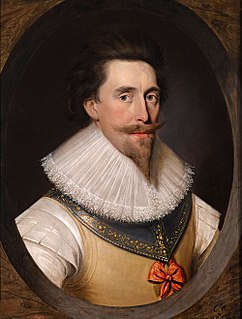
William Fiennes, 1st Viscount Saye and Sele was an English nobleman and politician, known also for his involvement in several companies for setting up overseas colonies.

Sir Samuel Egerton Brydges, 1st Baronet was an English bibliographer and genealogist. He was also Member of Parliament for Maidstone from 1812 to 1818.
Andrew Windsor, 1st Baron Windsor (1467–1543), was an English peer, M.P. and Keeper of the wardrobe, knight banneret and military commander.

Compton Verney is a parish and historic manor in the county of Warwickshire, England. The population taken at the 2011 census was 119. The surviving manor house is the Georgian mansion Compton Verney House.

Francis Fane, 1st Earl of Westmorland, of Mereworth in Kent and of Apethorpe in Northamptonshire was an English landowner and politician who sat in the House of Commons between 1601 and 1624 and then was raised to the Peerage as Earl of Westmorland.
Sir John Hobart, 2nd Baronet was an English politician and baronet.
Henry Stanhope, Lord Stanhope KB, known as Sir Henry Stanhope until 1628, was an English nobleman and politician.

Sir John St John, 1st Baronet of Lydiard Tregoze in the English county of Wiltshire, was a Member of Parliament and prominent Royalist during the English Civil War. He was created a baronet on 22 May 1611.

Sir William Maynard, 4th Baronet of Waltons, Ashdon, Essex was a British politician and baronet.
Thomas Brugge, de jure 5th Baron Chandos, was an English peer.
Events from the year 1742 in Wales.

Sir Anthony Cope of Hanwell, near Banbury, was an English author.

The manor of Bradwall was a manorial estate in the parish of Bradwall near Sandbach in Cheshire, which dates back to the 13th century. Several families have been associated with either the manor, or the more recent country seat at Bradwall Hall.

George Vernon was and a prosperous and hospitable landowner and MP in Derbyshire, who came from a long line of wealthy landowners. He was the son of Richard Vernon and Margaret Dymoke. His family seat was at Haddon Hall, England's best preserved medieval manor house and today a major tourist attraction. He was a Member (MP) of the Parliament of England for Derbyshire in 1542.
Sir Christopher More was an English administrator, landowner, and Member of Parliament. More was the son of John More, a London fishmonger, and his wife, Elizabeth. He was active in local administration in Sussex and Surrey, and from 1505 until his death held office in the Exchequer, rising in 1542 to the post of King's Remembrancer. His sister, Alice More, was the fourth wife of Sir John More, father of Sir Thomas More.
This article is about the particular significance of the year 1730 to Wales and its people.
Thomas Darcy, 1st Earl Rivers was an English peer and courtier in the reigns of Elizabeth I, James I and Charles I.
Sir Richard Devereux was a rising political figure during the reign of Henry VIII and Edward VI when his career was cut short by his sudden death during the life of his father. His son would complete the family's ascendency when he was created Earl of Essex.
Sir Edward Devereux was an English politician who sat in the House of Commons, and was an English Baronet.

Sir George Fermor of Easton Neston was an English soldier and landowner.










